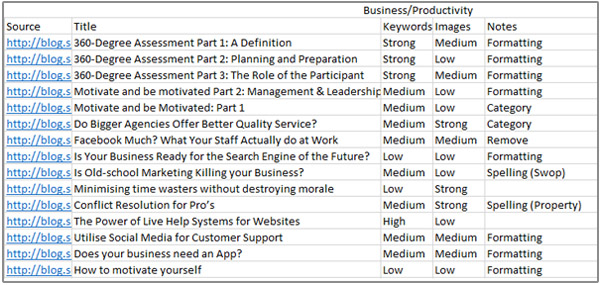Do you know exactly what content you have on your website? Is all your content relevant and complimentary to your brand?
The fact is few people are fully aware of all the content on their websites. We have been conditioned to oblige the ‘content is king’ approach by churning out masses of great (well, hopefully) content.
A Content audit will allow you to evaluate your website for redesign or for search engine optimization and serve as a reference for source content during the content development phase. Identifying exactly what content you have will aid you in determining your specific content needs and therefore allow you to set aside the necessary resources.
Now before you get started, there are a couple of questions that need to be answered:
- What do you want to learn, and why?
There is absolutely no point in doing a content audit if you haven’t established exactly what you need to find out. Every part of your Content Strategy must be impactful. This means knowing exactly what you’re trying to investigate so that you can feed the rest of your Content Strategy with the right strategic information.
- What do you need to prove and to whom?
The ‘what’ of your Content Strategy is just as important as the ‘who’. This also applies internally. For example: The head of content requires details about the performance of certain individual’s content, while the copywriter may need to know what available topics there are to supplement their research.
- How much time have you got?
A content Audit can vary greatly in detail, and (depending on how much content you have) may take a long time to complete. The whole process needs to achieve all your planned out goals. You don’t want to go through the whole process only to realise you never analysed certain pertinent elements. A content audit can easily span over hundreds, even thousands of pages; and if you’re not doing it right from the start then don’t get upset when you need to rescan all those pages ‘cause you forget something small!
- How far are you in the Content Strategy process?
A content audit completed in preparation of a Content Strategy will require significantly more data than one completed at a later stage in the process. Once again it boils down to proper planning.
Step 1: Taking Inventory
Click through every single piece of content you own and create a content inventory document (I suggest using an Excel spreadsheet). Taking inventory will include webpages, meta data, keywords, page title, images, audio, video, and documents. As tedious as this process may seem, it creates valuable content curation and repurposing opportunities.
Step 2: Creating Order
Create categories and sub categories under which you Catalogue your content by parent page and child page.
Step 3: Making Sense of it All
In order to make the most out of your content audit, ensure you’re asking the right questions.
- What does your content actually say? You cannot always judge a page by its title or sub headings alone. Read through your content and record your findings in a ‘notes’ column.
- Is the content accurate? Over time links may become inactive, product details may change and content may become dated. Add an ‘accuracy’ column to your inventory; a rating scale of 1-5 should work fine.
- Does your content provide value? Does your current content support your business objectives and provide users with the desired information? Create a ‘value to user’ and a ‘value to business’ column, again a rating scale of 1-5 should be just dandy.
- Is the content used by your audience? Implement analytics tools to measure user interaction with each page. Record your findings in the ‘notes’ column.
- Is the content written professionally? Check for spelling, grammar, tone, structure and any other technical issues. Record your findings in a ‘writing’ column with a (you guessed it!) 1-5 rating scale.
- Is the content user-friendly? Look at your content from the user’s perspective. Is your content focused on the needs of the user or filled with industry specific jargon? Add your results to a ‘user-friendliness’ column with the relevant scale.
Here's an example of a Content Audit I completed recently:

This article was inspired by the book Content Strategy for the Web by Kristina Halvorson, 2012.
Have any cool tips for Content Auditing? Share them with me by commenting below or connect with me on Twitter @JulianKarstel
Sound Idea Digital is a full service digital agency | www.soundidea.co.za
Julian Karstel is a Digital Marketing Consultant for Sound Idea Digital | Julian@soundidea.co.za
|
Request a Digital Marketing Services Consultation
|
[Back]
blog comments powered by Disqus

